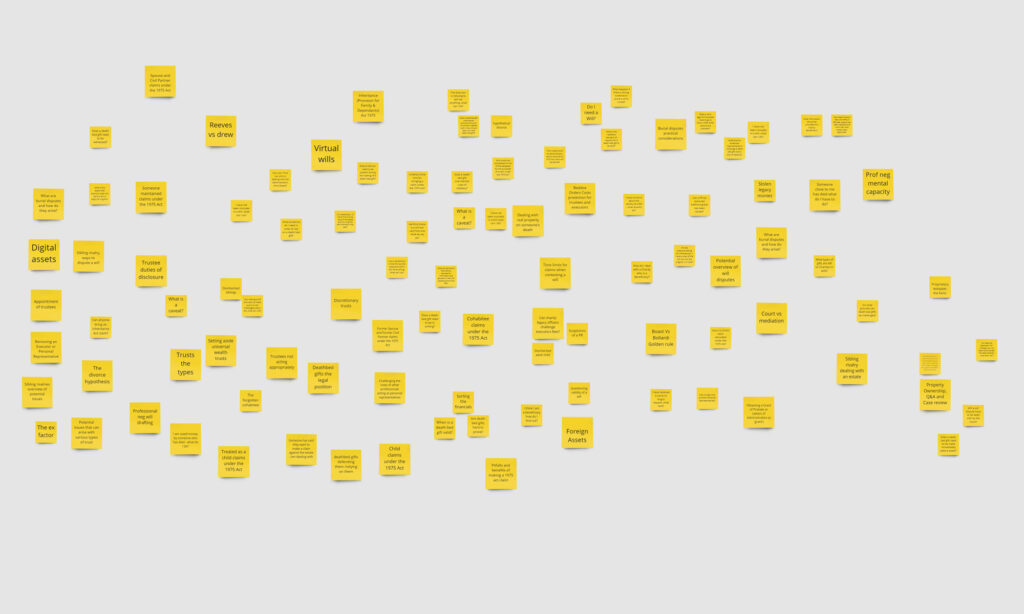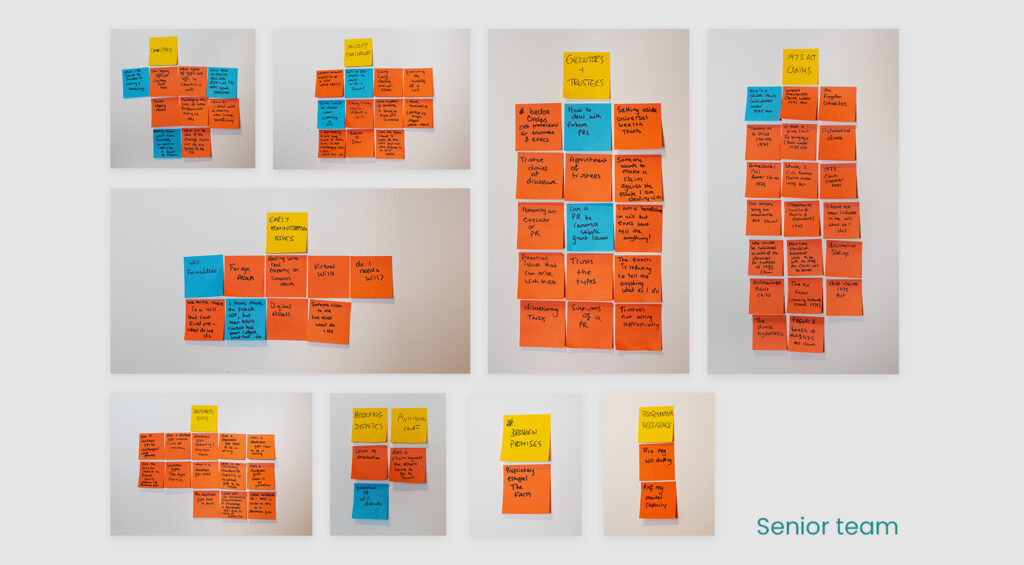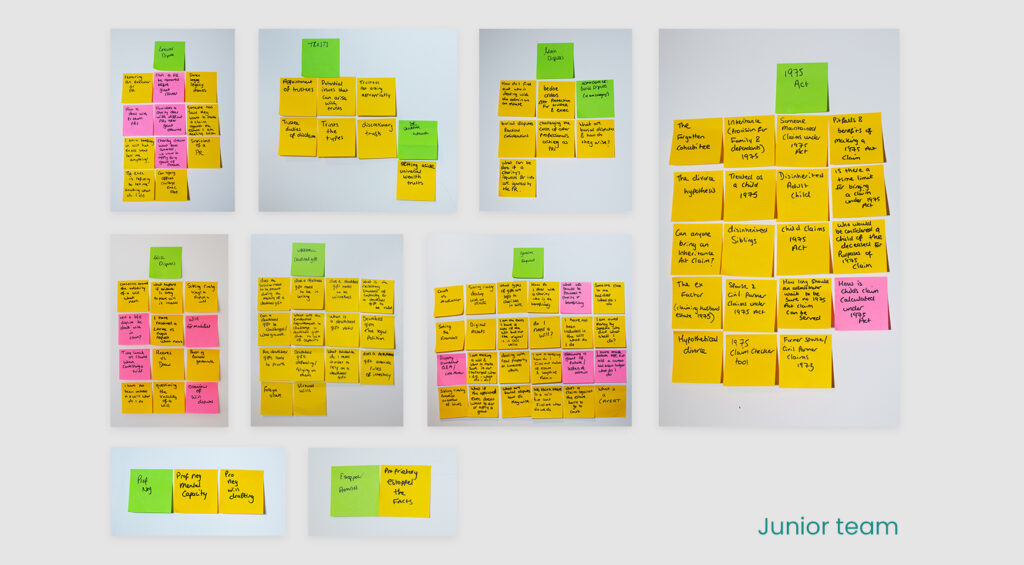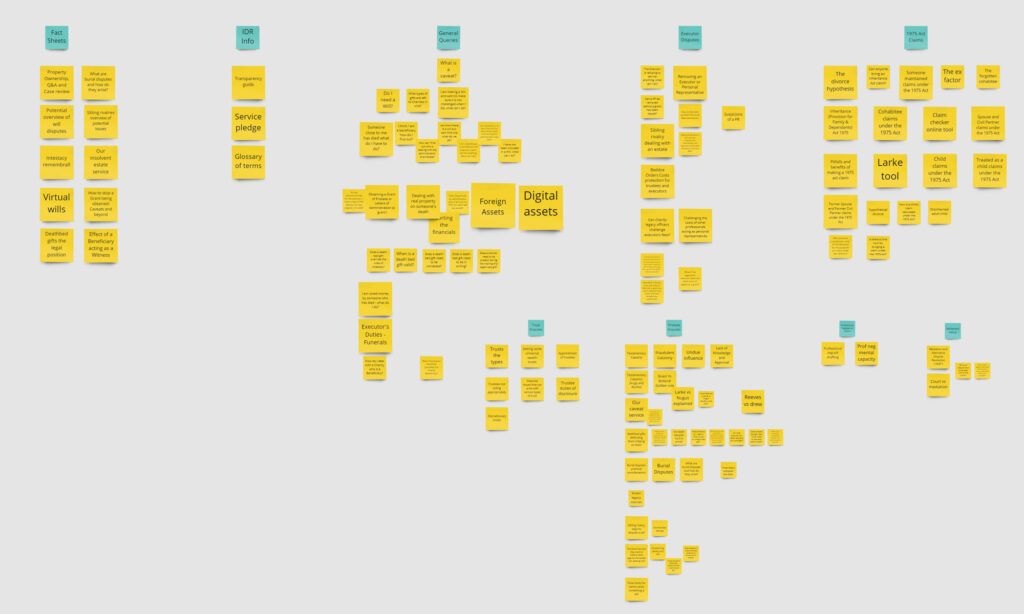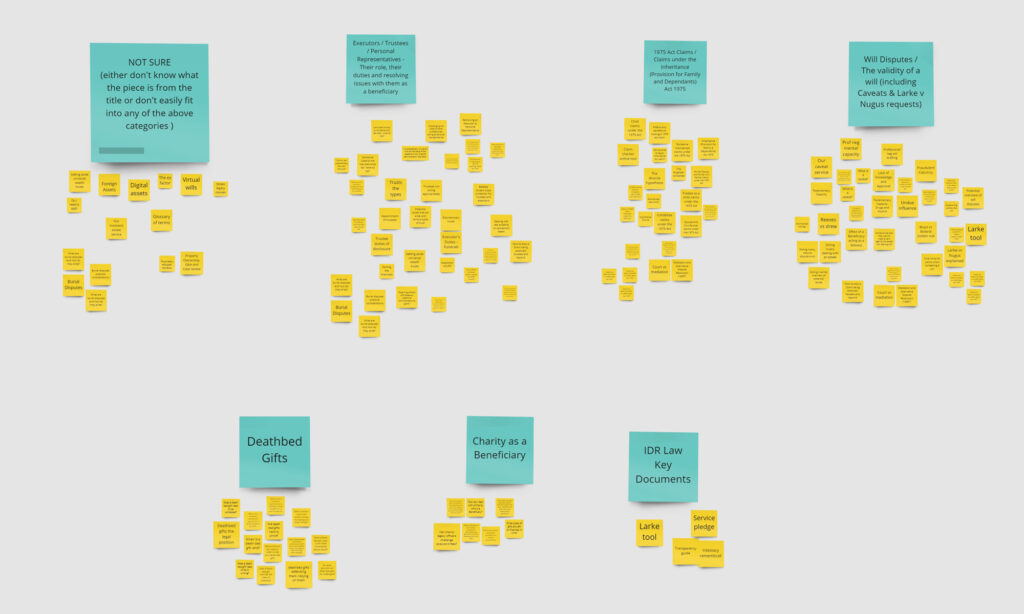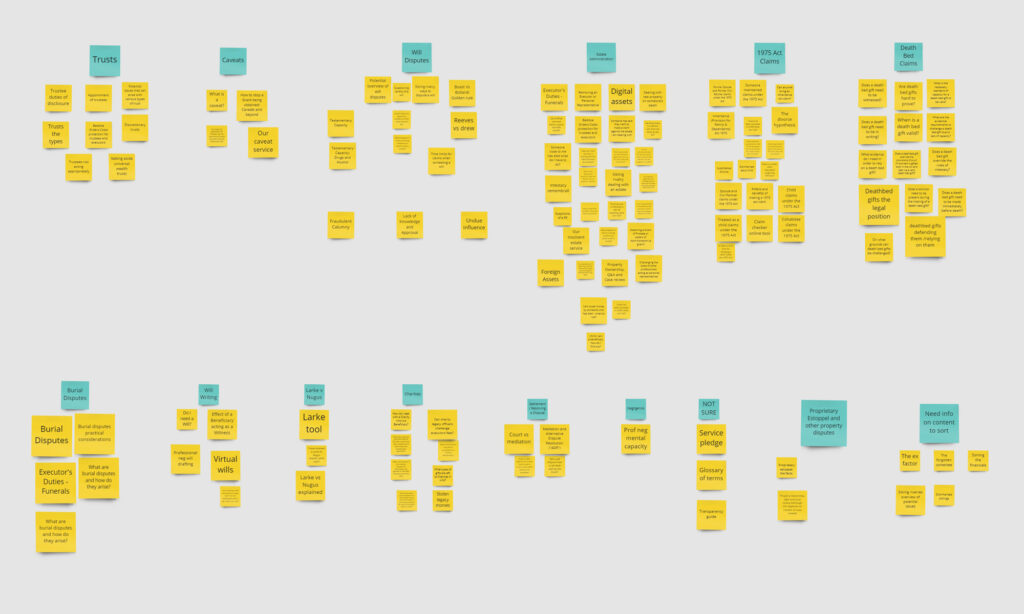IDR Law projects
Overview
Following investment, this specialist law firm needed to make its operation scalable, with a digital platform tailored to its referral led business model.
Working as a UX consultant, I took a leading role in the discovery, design, and development, along with the creation of supporting content.
The resulting platform formed the basis of the firms marketing strategy, underpinning operations in all departments, and facilitating growth.
Website strategy, design & content
Lead generation tool discovery, design & build
CRM discovery & design
Content strategy & creation
The business
IDR Law are specialists in resolving Inheritance disputes, which often occur between families following the death of a parent or relative.
They receive the bulk of their clients via referrals from professional practitioners working in law or family succession, such as solicitors, will writers, or financial advisors.
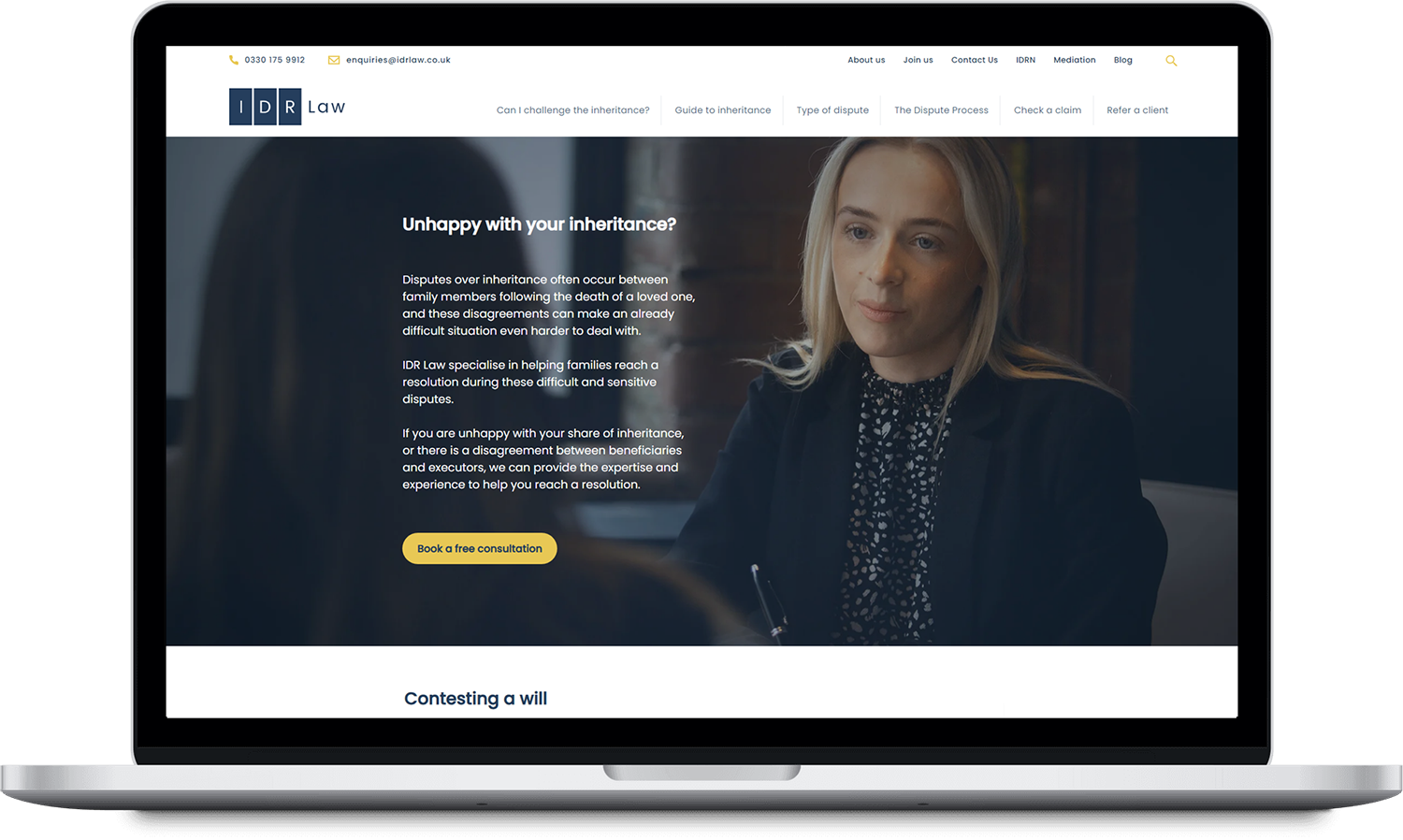
The clients
For most, it is the first and only time they will face these difficult situations, which are often sensitive and complicated. They want to know if anything can be done, if it will succeed, and how much it will cost.

Referrers
Referrers have clients involved in a dispute, but do not have the required expertise to assist, so they refer them to IDR Law. They range in legal knowledge and understanding of these complicated situations.

Business development
The BD team reach out to potential new referrers and engage with existing referrers to increase referrals. They use a variety activities to engage with their referrer base, via several communication channels.

Triage
Triage take new enquiries, and make an initial assessment on whether the case would be successful. lawyers make a further, more detailed assessment, and open cases if they are legally viable.

Objectives
- Making a complex field of law understandable to people dealing with an emotionally charged situation.
- Enabling these people to find the answers they need as quickly and easily as possible.
- Improving display of enquiry data to increase efficiency of case assessments.
- Give structure to a business development process that was previously ad-hoc.
- Enabling revenue based reporting on B2B referrals for the first time.
- Enabling the launch of B2C campaigns for the first time.
The biggest challenge was to unpick complexity, identify the most important information, and simplify its presentation for all audiences, both internal and external. This required close collaboration with the legal team to make use of their experience and legal expertise.

The platform
The three projects connect together as one platform to manage the business development and triage operations.
- Three websites with different audiences for client & referrer acquisition
- Lead generation form embedded in different locations, offering valuable content in exchange for enquiries.
- A CRM to manage all triage enquires and BD sales funnel.

The websites

IDR Network
- B2B engagement and referrals.
- Membership site
- Content strategy
- Valuable resource for professionals working in inheritance.

IDR Law
- Shop front
- B2C / B2B acquisition
- Focused on people facing disputes
- Provides the info they need with easy route to enquiry

Will Check
- B2C lead generation site.
- Destination for SEO & PPC campaigns
- Information for people facing disputes
- Embedded Claim Checker form for immediate answer and lead gen.
The Claim Checker
The Claim Checker is a tool that helps people facing an inheritance dispute. Users enter the details of their dispute, and the form calculates if they have the legal right to make a claim.
They can learn about all the issues relevant to inheritance disputes, and get a personalised report with guidance about their situation. IDR Law receive new leads straight into their CRM for assessment.

The CRM
End-to-end task flow through the business on a HubSpot platform.
BD workflow

Triage workflow

Research
The rest of this page describes the main research objectives, and explains exactly how the insights were gathered, and how they informed key design decisions.
If you haven’t got time for all that, you can go straight to the solutions…
Asking the right questions
Research objectives included:
- Understanding the user problem, and building a detailed persona of people facing an inheritance dispute.
- Understanding how triage assess cases so presentation of information can help streamline their processes.
- Establishing a hierarchy of information so the most important details are presented to audiences in the most useful way.

Persona

The IA & content design on both the Claim Checker lead-gen tool and the B2C websites was based entirely on the insights from this research.
- They need the answers they are seeking as quickly and easily as possible
- They want reassurance around all the issues
- They need to understand the legal reality of inheritance disputes
- The copy needs to be in a tone that accounts for the sensitivity of the situation
Streamlining case assessments
Finding a way to streamline case assessments was a key objective of the project, with the aim of reducing triage time.
The existing client management system:
- Enquiries presented in a block of text
- Notes from the phone call jumbled together in whatever order the client described them
- Often includes irrelevant information about their families and grievances
- Picking out the important details from this text takes time.
The first step towards a solution was to learn all about case assessment, with a series of internal surveys and interviews.
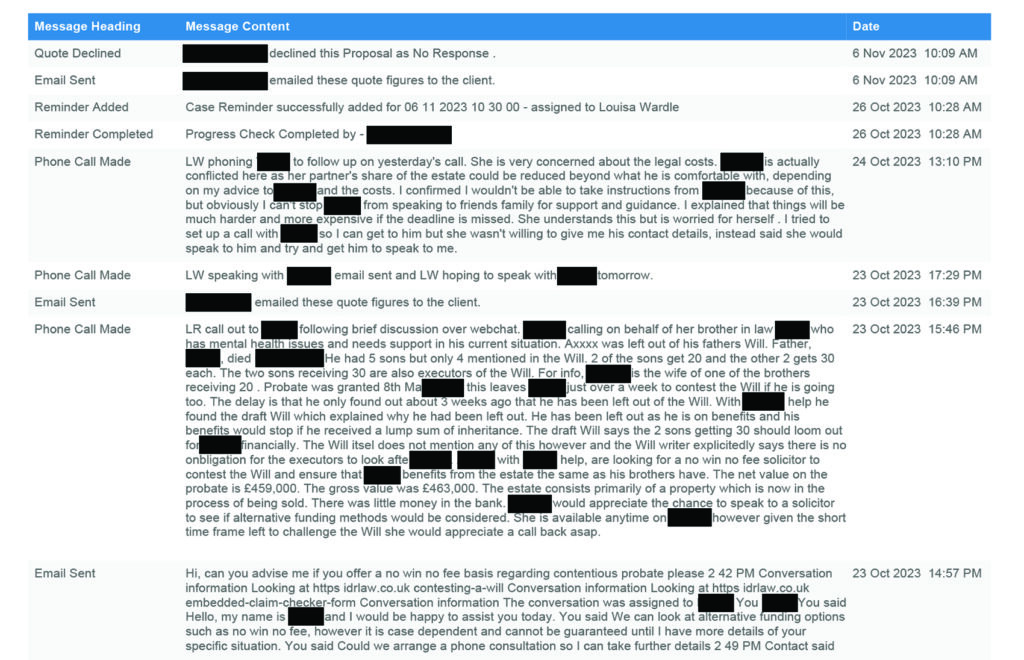
Existing enquiry system
1. First internal survey
Qualitative questions
The first survey asked four questions about triaging enquiries.
They contributed significantly to the persona, and set the ball rolling for streamlining enquiry data.
The internal surveys also helped involve the teams in the process, and collaborate on the solution they would be using in their day-to-day.
2. Identifying important details
Qualitative analysis
Their answers produced a list of details the lawyers use to assess cases, with a tally to show frequency.
Reasons to proceed or decline showed the important issues people consider when dealing with their family dispute.
Descriptions of initial conversations with clients gave a good indication of their pain points and goals.
3. Second internal survey
The list of data points was sent back to the team in another survey, which asked them to rank the importance of each detail in assessing cases.
The results pdf was sent with the survey to explain how their answers were shaping the design of the new enquiry management system.

4. Surprise winner!
Nature of dispute hadn’t appeared in the first survey results, but was included last minute as variation of ‘type of dispute’.
Type of dispute refers to the legal grounds on which a dispute can be raised, whereas nature of dispute is more how a client describes why they are unhappy.
Its the same as type of dispute, but in language a member of the public would typically use and understand, rather than legal terminology.
This clear winner in making a rough assessment was a key turning point, and had a significant impact on all areas of the project.

5. List of reasons
Based on the different types of inheritance dispute, a list of options was established that described them in layman’s terms.
The guidance explaining each option became an important part of helping people understand the legal context and overall situation.
The check boxes help the lawyers establish what type of dispute is being described, and help them assess the legal viability.
6. CRM enquiry record
This question was replicated in the HubSpot enquiry properties, along with all the other required fields.
Enquiry records now have these options displayed clearly in the left sidebar, alongside the paragraphs of text.
7. Website copy
The same approach of describing types of dispute in layman’s terms was repeated on the websites to help people quickly recognise their situation, and relate it to the legal grounds for dispute.
Match Between the System and the Real World
This follows Jakob’s usability heuristic by speaking the users language, but it also helps the lawyers interpret their situation without having to read through paragraphs of text.
Card sorts
The lawyers were also enlisted to re-categorise the content resource, which was proving difficult to navigate.
A series of card sorts were carried out by individual lawyers, and also as a group exercise at the away day, working in teams to categorise the topics.























